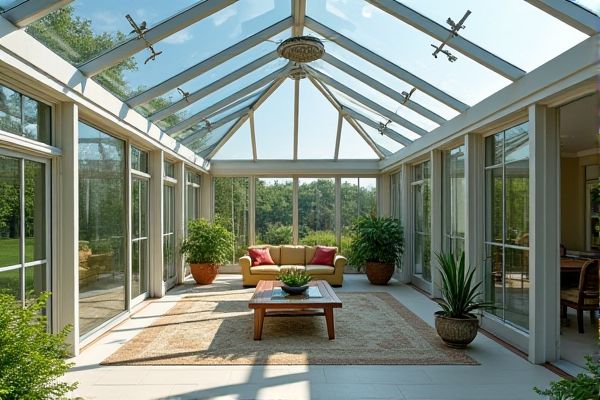
A glass roof offers superior clarity and elegance, maximizing natural light and providing a sleek, modern aesthetic to your sunroom, while a polycarbonate roof excels in durability, impact resistance, and UV protection, often at a lower cost. Explore the full article to discover which roofing option best suits your sunroom needs and lifestyle.
Table of Comparison
| Feature | Glass Roof | Polycarbonate Roof |
|---|---|---|
| Material | Tempered or laminated glass | Multiwall or solid polycarbonate sheets |
| Light Transmission | Up to 90% natural light | 70% to 80% natural light |
| Thermal Insulation | Moderate, can be enhanced with double glazing | High insulation with multiwall options |
| Weight | Heavier, requires stronger support | Lightweight, easier installation |
| Durability | Highly durable, resistant to scratches and weather | Strong impact resistance, may scratch more easily |
| UV Protection | Depends on coating; usually requires UV treatment | Built-in UV filters |
| Cost | Higher initial cost | More affordable |
| Noise Reduction | Better sound insulation | Less effective for noise reduction |
| Maintenance | Easy to clean, minimal upkeep | Requires regular cleaning to prevent discoloration |
| Ideal Use | Elegant sunrooms with clear views | Cost-effective sunrooms with good insulation |
Introduction to Sunroom Roofing Options
Sunroom roofing options primarily include glass roofs and polycarbonate roofs, each offering distinct advantages in terms of durability, insulation, and light transmission. Glass roofs provide superior clarity and aesthetic appeal with higher solar heat gain, making them ideal for bright, visually appealing sunrooms. Polycarbonate roofs excel in impact resistance, UV protection, and thermal insulation, offering a lightweight yet robust alternative suited for energy-efficient sunroom designs.
Glass Roofs: Overview and Benefits
Glass roofs in sunrooms offer superior clarity and natural light transmission, enhancing your indoor experience with panoramic outdoor views. These roofs provide excellent durability, UV protection, and energy efficiency by minimizing heat loss while maintaining a sleek, modern aesthetic. Investing in a high-quality glass roof enhances your sunroom's value and comfort, making it a preferred choice for long-term performance and style.
Polycarbonate Roofs: Features and Advantages
Polycarbonate roofs for sunrooms offer exceptional durability and impact resistance, making them ideal for withstanding harsh weather conditions without cracking or breaking. Their lightweight composition allows for easier installation and enhanced structural support compared to traditional glass roofs, while providing excellent UV protection that helps maintain a cooler indoor environment. Choosing a polycarbonate roof ensures long-lasting performance with minimal maintenance, optimizing your sunroom's comfort and energy efficiency.
Insulation and Energy Efficiency Comparison
Glass roofs offer superior thermal insulation and energy efficiency due to their ability to incorporate double or triple glazing with low-emissivity coatings, reducing heat loss and solar heat gain effectively. Polycarbonate roofs, while lighter and more impact-resistant, provide less insulation and allow more heat to pass through, potentially increasing cooling costs. Your choice between these materials influences the energy performance and comfort of your sunroom, with glass roofs typically delivering better insulation benefits.
Natural Light Transmission: Glass vs Polycarbonate
Glass roofs offer superior natural light transmission, typically allowing around 90% of sunlight to pass through, creating bright and clear indoor environments. Polycarbonate roofs, while more impact-resistant and lightweight, generally transmit about 70-80% of natural light, which can result in a slightly dimmer sunroom experience. Your choice between glass and polycarbonate will affect the brightness level and overall ambiance of your sunroom, balancing light clarity against durability and insulation needs.
Durability and Lifespan of Roofing Materials
Glass roofs offer exceptional durability with a lifespan often exceeding 30 years, maintaining clarity and resisting scratches over time, making them a premium choice for sunrooms. Polycarbonate roofs, known for impact resistance and flexibility, typically last 10-15 years but may yellow or weaken due to prolonged UV exposure despite UV protective coatings. Both materials require proper maintenance to maximize lifespan, but glass provides superior longevity and aesthetic retention in sunroom roofing applications.
Maintenance Requirements for Each Roof Type
Glass roofs in sunrooms require regular cleaning to maintain clarity and occasional inspection for cracks or sealant damage, ensuring long-term durability. Polycarbonate roofs offer easier maintenance with their impact-resistant surface that resists yellowing and can be cleaned with mild soap and water. Your choice depends on whether you prefer the premium look of glass with careful upkeep or the low-maintenance, durable polycarbonate option.
Cost Analysis: Glass Roof vs Polycarbonate Roof
Glass roofs for sunrooms typically cost between $45 and $75 per square foot, offering superior durability and clarity but requiring higher initial investment and professional installation. Polycarbonate roofs range from $10 to $30 per square foot, providing a budget-friendly alternative with lightweight material and easier handling, though they may have reduced lifespan and UV clarity compared to glass. Factoring in maintenance and energy efficiency, glass roofs often incur lower long-term expenses despite the upfront cost difference.
Aesthetic Appeal and Design Flexibility
Glass roofs offer a sleek, modern aesthetic with crystal-clear transparency that enhances natural light and showcases outdoor views in your sunroom. Polycarbonate roofs provide greater design flexibility through various color tints and impact-resistant panels, allowing you to customize durability and style based on your space's needs. Choosing between glass and polycarbonate hinges on your preference for elegance or versatile customization in your sunroom design.
Making the Right Choice for Your Sunroom
Selecting between a glass roof and a polycarbonate roof for your sunroom depends on factors like durability, insulation, and light transmission. Glass roofs provide superior clarity and UV protection but are heavier and may require stronger structural support, while polycarbonate roofs offer excellent impact resistance, better insulation, and lightweight flexibility. Prioritizing energy efficiency, maintenance needs, and budget ensures the right sunroom roofing choice tailored to your specific climate and lifestyle.
 homyna.com
homyna.com